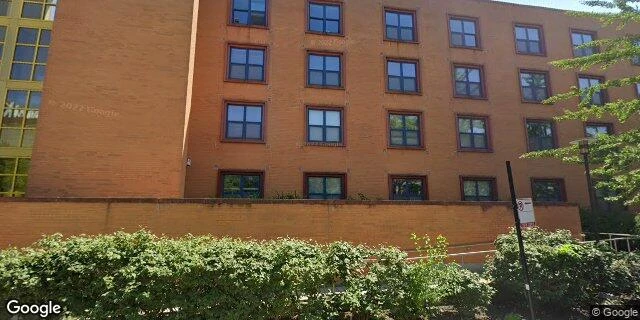Max Palevsky Residential Commons/Bartlett Commons
Chicago Building ID: 252036

Attribution: © Google 2025
Building Info
- Square Footage
- 69,250 sqftLower than 83% of all buildings1/2 median139,707 sqft0.7x median Social/Meeting Hall94,280.5 sqft
- Built
- 1904
- Primary Property Type
- Social/Meeting Hall
- Community Area
- Hyde Park
- Ward
- 5
-
Chicago Energy Rating
- 2.0 / 4
- Owner

Note: Owner manually tagged. Logo used under fair use.
2022 Report Card
Debug Full Grade Data
- AvgPercentileLetterGrade: D
- AvgPercentileGrade: 37.33502113826433
- GHGIntensityLetterGrade: F
- GHGIntensityPercentileGrade: 2.3921568627450966
- EnergyMixLetterGrade: B
- EnergyMixWeightedPctSum: 36.74078251641069
- EnergyMixPercentileGrade: 65.34735676722946
- SubmittedRecordsLetterGrade: A
- MissingRecordsCount: 0.0
- SubmittedRecordsPercentileGrade: 100.0
Emissions & Energy Information for 2022
- Greenhouse Gas Intensity F
- 20.1 kg CO2e / sqftHigher than 98% of all buildings3.1x median6.4 kg CO2e / sqft1.4x median Social/Meeting Hall14.1 kg CO2e / sqft
- Total Greenhouse Gas Emissions
- 1,388 tons CO2eHigher than 66% of all buildings1.6x median885.8 tons CO2e1.2x median Social/Meeting Hall1,177.8 tons CO2e
Years Reported
8/8
A

2015
2016
2017
2018
2019
2020
2021
2022
Energy Breakdown
- Fossil Gas Use (aka Natural Gas)
- 1,480,720 kBtuEst. Gas Bill: $18,000 for 2022**Lower than 87% of all buildings1/4 median5,818,399.6 kBtu2.0x median Social/Meeting Hall740,360 kBtu
- Electricity Use
- 4,248,890 kBtuEst. Electric Bill: $178,000 for 2022**Higher than 54% of all buildings1.1x median3,796,376.7 kBtu1.2x median Social/Meeting Hall3,478,704.9 kBtu
- District Steam Use
- 9,575,844 kBtu
Most buildings don't use district steam, so we don't currently have comparison data.
- District Chilled Water Use
- 2,172,732 kBtu
Most buildings don't use district chilling, so we don't currently have comparison data.
Energy Mix B
Total Energy Use: 17,478,187 kBTU
View Extra Technical & Historic Info
- Source Energy Usage Intensity
- Not Reported
This data was not reported for this building this year, which likely means a value of zero for this field.
- Site Energy Usage Intensity
- Not Reported
This data was not reported for this building this year, which likely means a value of zero for this field.
Full Historical Data Table for Max Palevsky Residential Commons/Bartlett Commons
| Year |
Overall Grade |
Emissions Intensity Sub-Grade |
Energy Mix Sub-Grade |
Reporting Mix Sub-Grade | GHG Intensity kg CO2e / sqft | GHG Emissions metric tons CO2e | Energy Mix | Electricity Use kBTU | Fossil Gas Use kBTU |
District Steam Use kBTU |
District Chilled Water Use kBTU | Source EUI kBTU / sqft | Floor Area sqft |
Chicago Energy Rating |
Energy Star Score |
|---|---|---|---|---|---|---|---|---|---|---|---|---|---|---|---|
| 2015 | A | B | A | A | 8.1 | 2,430 | 100%Electricity 0%Fossil Gas 0%Other | 12,093,561 | - | - | - | 126.8 | 299,490 | - | - |
| 2016 | C | F | B | A | 13.8 | 4,137 | 27%Electricity 5%Fossil Gas 46%Other | 11,866,250 | 2,029,490 | 20,196,414 | 9,518,400 | 244.4 | 299,490 | - | - |
| 2017 | D | F | C | A | 14.1 | 4,209 | 28%Electricity 6%Fossil Gas 54%Other | 12,001,471 | 2,444,000 | 23,687,766 | 5,458,548 | 247.8 | 299,490 | - | - |
| 2018 | C | F | B | A | 13.9 | 4,151 | 26%Electricity 3%Fossil Gas 57%Other | 12,077,477 | 1,580,170 | 26,067,432 | 6,208,686 | 242 | 299,490 | 1.0 | - |
| 2019 | C | D | B | A | 10.8 | 3,969 | 26%Electricity 5%Fossil Gas 57%Other | 11,809,294 | 2,051,310 | 25,810,591 | 5,757,544 | 193.9 | 368,740 | 2.0 | - |
| 2020 | C | D | B | A | 7.7 | 2,296 | 36%Electricity 0%Fossil Gas 50%Other | 8,537,744 | - | 11,775,037 | 3,461,581 | 137.6 | 299,490 | 3.5 | 72.0 |
| 2021 | B | C | B | A | 6.7 | 2,002 | 27%Electricity 0%Fossil Gas 55%Other | 6,381,269 | - | 13,031,376 | 4,286,249 | 125 | 299,490 | 3.5 | 78.0 |
| 2022 | D | F | B | A | 20.1 | 1,388 | 24%Electricity 8%Fossil Gas 55%Other | 4,248,891 | 1,480,720 | 9,575,844 | 2,172,732 | 389.2 | 69,250 | 2.0 | - |
* Note on Rankings: Rankings and medians are among included buildings, which are those who reported under the Chicago Energy Benchmarking Ordinance for the year 2022, which only applies to buildings over 50,000 square feet.
** Note on Bill Estimates:
Estimates for gas and electric bills are based on average electric and
gas retail prices for Chicago in 2021 and
are rounded. We expect large buildings would negotiate lower rates with
utilities, but these estimates serve as an upper bound of cost and help
understand the volume of energy a building is used by comparing it to
your own energy bills! See our
Chicago Gas & Electric Costs Source
for the original statistics.
Data Source:
Chicago Energy Benchmarking Data